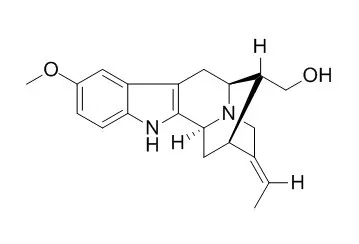| Description: |
Lochnerine shows potent vasorelaxant activity, it also shows some antitumor activity, it can bring about complete inhibition of cell growth in P388 leukemia cells in vitro. |
| Targets: |
NO | Calcium Channel |
| In vitro: |
| Jpn J Cancer Res. 1986 Feb;77(2):197-204. | | Non-antitumor vinca alkaloids reverse multidrug resistance in P388 leukemia cells in vitro.[Pubmed: 3082832] | Twelve monomeric or dimeric alkaloids from Vinca rosea Linn., which had been reported to have little or no antitumor activity, were investigated to determine their combined effects with either vincristine or daunorubicin on in vitro cell growth of a P388 subline resistant to vincristine and cross-resistant to anthracyclines.
METHODS AND RESULTS:
We found that the combinations at subcytotoxic concentrations induced significant growth inhibition of the resistant cells, but not of the sensitive cells. Of the alkaloids examined, catharine, vindoline, catharanthine, vincarodine, and Lochnerine were able to bring about complete inhibition of cell growth. Further in vitro study using vindoline revealed that at 10 micrograms/ml it was able to completely reverse not only resistance to vincristine but also cross-resistance to vinblastine, daunorubicin, and adriamycin. In addition, we found that vinca alkaloids active in reversing resistance possess potent activities to enhance the net uptake of not only vincristine but also daunorubicin by the resistant cells, and this effect was proved to result from their inhibitory action on the active efflux process.
CONCLUSIONS:
These results provide further support for our hypothesis that both anthracyclines and vinca alkaloids can inhibit their own efflux process by interacting with the cell membrane, and this similarity provides a basis for their reciprocal cross-resistance, irrespective of their different chemical structures. |
|
| In vivo: |
| J Nat Med. 2013 Jan;67(1):9-16. | | Vasorelaxant activity of indole alkaloids from Tabernaemontana dichotoma.[Pubmed: 22350216] | The aim of this study was to search for bioactive natural products from medicinal plants targeting vasorelaxant activity and we found the methanol extract from bark of Tabernaemontana dichotoma showed vasorelaxant activity on rat aorta.
METHODS AND RESULTS:
We isolated eight indole alkaloids including 10-methoxyalstonerine (1), a new macroline type indole alkaloid, from bark of T. dichotoma. These were respectively identified as 10-methoxyaffinisine (2), Lochnerine (3), cathafoline (4), (-)-alstonerine (5), 19,20-dehydro-10-methoxytalcarpine (6), alstonisine (7), and alstonal (8) based on spectroscopic analysis. Among them, sarpagine type (2 and 3), akuammiline type (4), and macroline oxindole type (7 and 8) showed potent vasorelaxant activity. Mechanism of action on vasorelaxant activity of 10-methoxyaffinisine (2), cathafoline (4), and alstonisine (7) was clarified.
CONCLUSIONS:
Effects of 10-methoxyaffinisine (2), cathafoline (4), and alstonisine (7) were partially mediated the NO release from endothelial cells. Furthermore, 10-methoxyaffinisine (2) and alstonisine (7) attribute to the inhibitory effect of VDC and ROC, and cathafoline (4) have inhibitory effect on Ca(2+) influx via ROC. In addition, 10-methoxyaffinisine (2) as a major compound from bark of T. dichotoma showed hypotensive effect on normotensive rats in vivo. |
|






 Cell. 2018 Jan 11;172(1-2):249-261.e12. doi: 10.1016/j.cell.2017.12.019.IF=36.216(2019)
Cell. 2018 Jan 11;172(1-2):249-261.e12. doi: 10.1016/j.cell.2017.12.019.IF=36.216(2019) Cell Metab. 2020 Mar 3;31(3):534-548.e5. doi: 10.1016/j.cmet.2020.01.002.IF=22.415(2019)
Cell Metab. 2020 Mar 3;31(3):534-548.e5. doi: 10.1016/j.cmet.2020.01.002.IF=22.415(2019) Mol Cell. 2017 Nov 16;68(4):673-685.e6. doi: 10.1016/j.molcel.2017.10.022.IF=14.548(2019)
Mol Cell. 2017 Nov 16;68(4):673-685.e6. doi: 10.1016/j.molcel.2017.10.022.IF=14.548(2019)